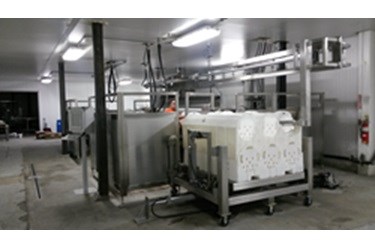NEXT HPP Announces Collaboration Effort With High Pressure Processing Science Experts To Reduce Cost Of Pasteurization Of Natural And Organic Foods

White Pigeon, MI (PRWEB) - The High Pressure Processing (HPP) industry is exploding with growth as HPP has become widely adapted across large spectrum food and beverage groups. HPP is a fully commercialized technology that uses cold-water combined with high pressure to drastically extend the shelf life of fresh products. HPP has gained wide acceptance in North America and it is gaining acceptance in global food manufacturing.
The industry has seen the adoption of 600 MPa or 87,000 PSI as the pressure standard used across many of the food groups. The pressures generated by these machines are greater than the pressure at 5 depths of the deepest part of the ocean and it is at these tremendous pressures that this technology inactivates harmful bacteria.
According to Tatiana Koutchma PhD, “The objective of HPP process validation is to demonstrate that the critical limits of HPP process established for the given product are capable of providing the necessary microbial lethality. In the case of establishment of HPP treatment for RTEs, this means that a specific pressure (typically 600 MPa) and hold time (3 to 5 min) can be tied to a specific level of reduction of vegetative cells of pathogenic organisms.”
Keith Warriner, PhD states, “In Canada the foods are still considered novel and hence need to go through a different Health Canada approval stream. Essentially, a Novel Food has to prove that there are no toxicology issues and the treatment brings some benefits. This process is a pain and companies in the early days could quite easily spend >$40k on studies and 4 years to complete the process." Warriner further explains, “As a consequence, companies ride on the back of other applications in saying the treatment will be 600 MPa / 87,000 Psi for a 3 minute hold time with a total of 9 minutes. As runs fail, the treatment needs to be restarted and repeated. In the US, foods treated with HHP are no longer considered novel and hence there is more flexibility in terms of treatment times and pressures.” Lastly Warriner comments, “However, the big thing missing is which strains and surrogates to apply in validation studies that represent worse case scenarios. There is significant strain variation in terms of bar tolerance and hence even in the event of a successful HHP validation study using lower pressure and time there is a tendency to stay with 600 MPa for 3 minutes. We are currently performing research to identify which strains and surrogates can be applied so hopefully this will yield results to help the validation process along.”
So what are the possibilities to optimize the control parameters? Tatiana Koutchma, PhD states, “You have to take into account the primary control points of Pressure (400 MPa to 600 MPa), Pressure up Time, Process Water Temperature, and Product Temperature.”
What does this mean for costs of running a HPP Machine? HPP Machines by the nature of Ultra High Pressure are going to breakdown more frequently than other food processing equipment. It stands to reason the higher the pressure the more frequent the machine downtime. When a machine leaks as it builds pressure it will continue to leak once it achieves maximum recipe pressure and will lose pressure during the holding process. By losing pressure during the holding phase you run the risk of having pressures come down and ultimately breach the critical control parameter resulting in product having to be reprocessed. The higher the pressure the longer the hold times the less processed HPP produced by the Machine. By not optimizing the recipe for the critical control parameters companies that process large volumes of product exponentially increase their costs to HPP their product.
“By addressing efficiency of pressure and hold times upfront companies save many times over on the backend,” states Gerald Ludwick, Managing Director for NEXT HPP. Gerald Ludwick further explains, “By not optimizing the recipe for the critical control parameters companies that processing large volumes of product exponentially increase their costs to HPP Product.”
NEXT HPP has designed its machines to minimize leaks by eliminating bends in tubing, keeping tube lengths short, and having all movements working in unison. The company has designed the machine pressurizing process to maximize the time to get to the desire pressure and at the same-time minimize the holding time by accounting for the predictive leaks resulting in decreased the cycle times.
About NEXT HPP
We are small, nimble, unique and responsive to this rapidly changing industry. We design to the unanswered and future needs of the industry. All machines come standard with automatic loading and unloading, tractability, reporting, intuitive PM and simplicity. Service is paramount and we’ve designed non-proprietary parts as every turn. We focus on local support where you live and work.
Source: PRWeb
View original release here: http://www.prweb.com/releases/2015/08/prweb12889229.htm
